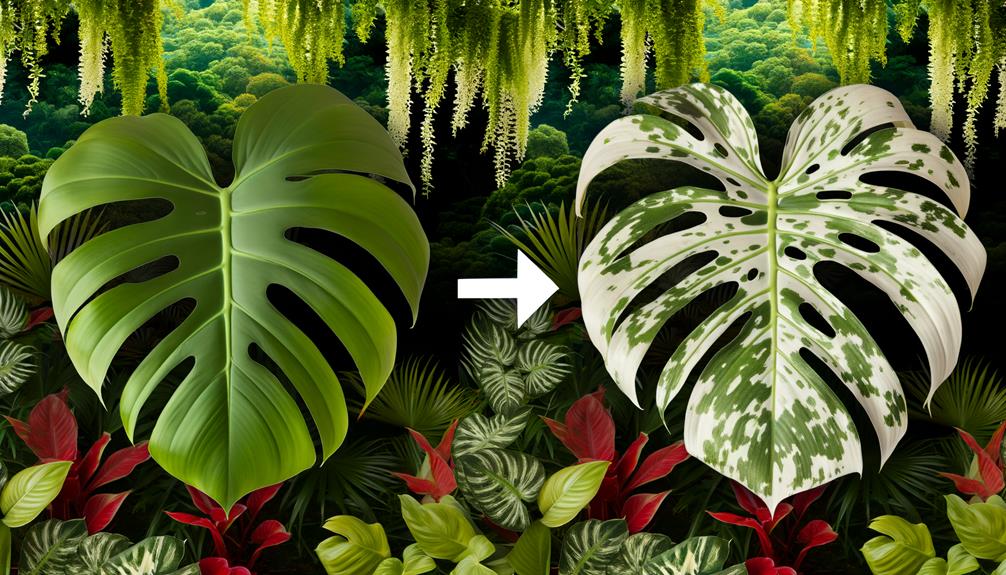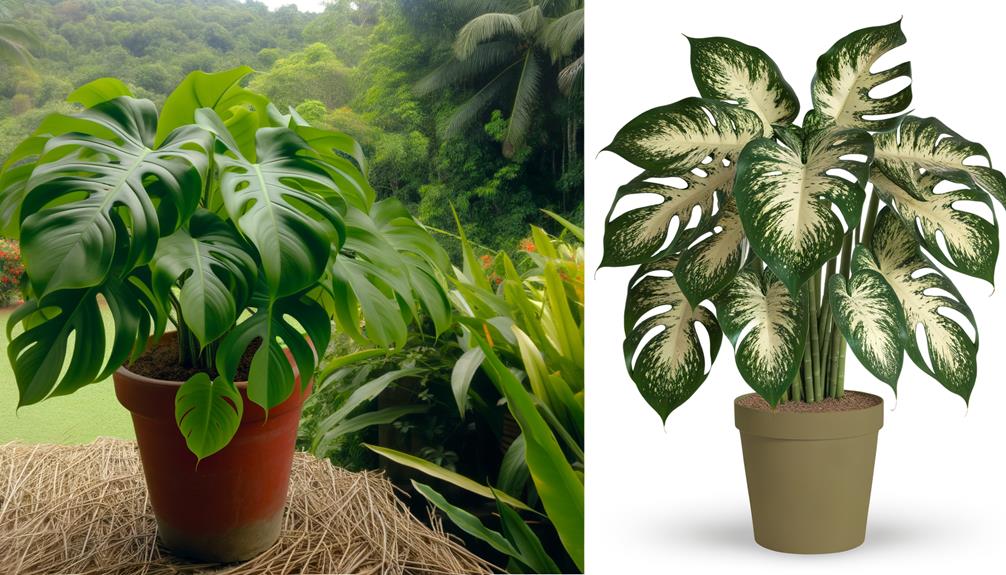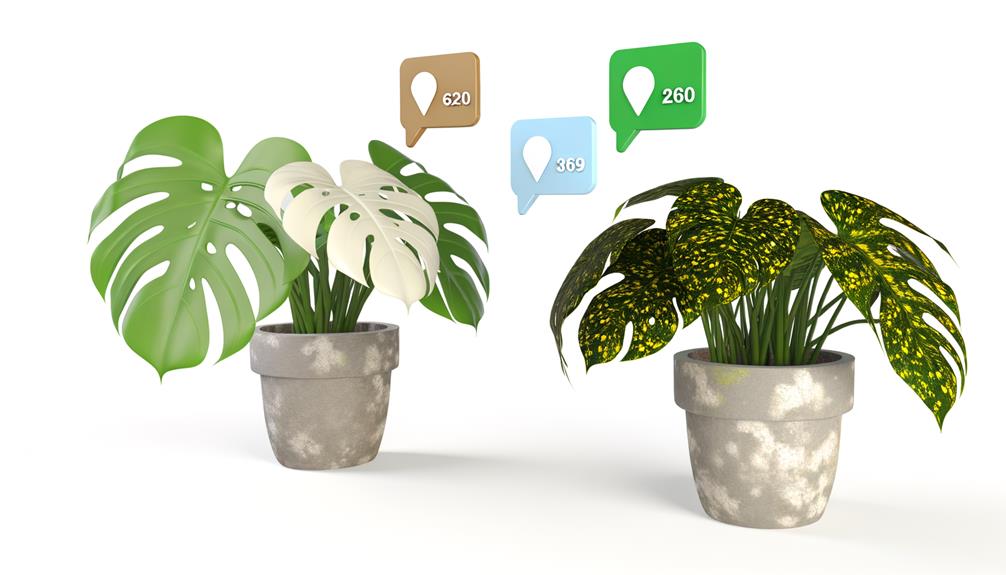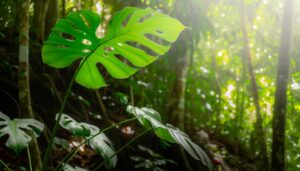Monstera Albo Vs Thai Constellation: Key Differences!
When comparing Monstera Albo and Thai Constellation, you’re looking at two distinct variegated forms of Monstera deliciosa. Monstera Albo’s irregular white patches result from genetic mutations in wild populations, while Thai Constellation’s consistent cream speckling is lab-developed via tissue culture.
Albo features larger, faster-growing leaves due to higher chlorophyll content, contrasting with the smaller, slower-growing Thai Constellation. Both thrive in bright, indirect light and high humidity, but Albo often needs more frequent watering.
While Albo is rarer and more expensive, Thai Constellation is more available and affordable. Understanding these differences helps you appreciate each plant’s unique beauty and requirements.

Monstera Albo vs. Thai Constellation: Quick Comparison Table
| Feature | Monstera Albo | Monstera Thai Constellation |
|---|---|---|
| Variegation | White and green, marbled or sectoral | Creamy yellow/white speckles and marbling |
| Leaf Size | Large, up to 2-3 feet | Large, similar size to Monstera Albo |
| Fenestrations | Present, develops with age | Present, develops with age |
| Growth Habit | Climbing, needs support | Climbing, needs support |
| Light Requirements | Bright, indirect light | Bright, indirect light |
| Watering | Keep soil moist, water when top inch is dry | Keep soil moist, water when top inch is dry |
| Humidity | Prefers high (60% or higher) | Prefers high (60% or higher) |
| Soil Type | Well-draining, peat-based | Well-draining, peat-based |
| Fertilization | Balanced, every 4-6 weeks in growing season | Balanced, every 4-6 weeks in growing season |
| Propagation | Stem cuttings with node and aerial root | Stem cuttings with node and aerial root |
| Pests | Spider mites, aphids, mealybugs | Spider mites, aphids, mealybugs |
| Special Care | Prune to manage size | Prune to manage size |
| Availability | Relatively rare, higher price | More widely available, still rare |
| Growth Rate | Slightly slower due to variegation | Generally faster than Monstera Albo |
Origin and History

Monstera Albo and Thai Constellation, both variegated forms of Monstera deliciosa, have distinct origins that contribute to their unique characteristics and appeal among plant enthusiasts.
Monstera Albo originates from naturally occurring genetic mutations within wild populations. This mutation results in sporadic white variegation on the leaves, creating its signature marbling effect.
Conversely, Thai Constellation was specifically developed through tissue culture techniques in a Thai laboratory. This controlled environment allowed for the consistent, stable introduction of cream-colored variegation.
Understanding these origins helps you appreciate the genetic stability and propagation methods that differentiate these plants. Monstera Albo‘s natural mutation can lead to variable variegation, while Thai Constellation offers a more uniform pattern due to its engineered development.
Variegation Patterns
The variegation patterns in Albo and Thai Constellation exhibit distinct differences. Albo showcases irregular, splotchy white patches, while Thai Constellation presents a more consistent, cream-colored speckling.
Albo’s variegation results from a mutation causing chlorophyll deficiency in certain leaf cells, leading to stark white sections. These white areas can appear unpredictably across the leaf surface, creating a unique, mosaic-like pattern.
Conversely, Thai Constellation’s variegation, produced through tissue culture, results in more uniform cream speckles distributed throughout the leaf. This pattern resembles star constellations, hence the name.
The cream color in Thai Constellation is due to stable chlorophyll mutations, ensuring that the variegation remains consistent as the plant matures. Understanding these patterns helps in identifying and appreciating each plant’s unique aesthetic.
Growth and Size

When comparing Monstera Albo and Thai Constellation, you’ll notice distinct differences in leaf size and growth rate.
Monstera Albo typically exhibits larger, more fenestrated leaves, while Thai Constellation’s leaves are generally smaller but more uniformly patterned.
Additionally, Monstera Albo tends to grow faster, making it more vigorous in ideal conditions.
Leaf Size Comparison
Leaf size in Monstera Albo and Thai Constellation varies greatly, with the former typically producing larger, more fenestrated leaves under ideal conditions. Monstera Albo’s leaves can reach up to 3 feet in length, showcasing pronounced fenestrations (natural holes) that increase with maturity. These fenestrations enhance light penetration and air flow, essential for photosynthesis and respiration.
In contrast, Thai Constellation’s leaves are generally smaller, usually maxing out at around 2 feet. While they also exhibit fenestrations, they tend to be less extensive. Thai Constellation leaves display a unique, variegated pattern of creamy white speckles, a result of chlorophyll deficiency in certain cells.
Both cultivars thrive under bright, indirect light, but their leaf sizes reflect genetic differences and specific environmental needs.
Growth Rate Differences
Given the variance in leaf size, it’s important to note that Monstera Albo typically shows a quicker growth rate in comparison to Thai Constellation, influenced by its strong genetic composition and elevated chlorophyll content.
Understanding this, you’ll observe that Monstera Albo’s accelerated growth is due to its higher photosynthetic efficiency, allowing for rapid expansion and larger foliage.
In contrast, the Thai Constellation has a slower growth rate because its variegation reduces chlorophyll concentration, limiting photosynthesis. This difference in growth rates means that while Monstera Albo will likely reach maturity faster, Thai Constellation demands more patience and care.
Both plants, however, require ideal conditions—ample indirect light, high humidity, and well-draining soil—to thrive and exhibit their unique variegated beauty.
Care Requirements
To maximize growth for Monstera Albo and Thai Constellation, you’ll need to understand their specific light and watering needs, as well as their soil and humidity preferences.
Both plants require bright, indirect light and consistent moisture levels, but not waterlogged soil.
Additionally, maintaining high humidity and using well-draining, nutrient-rich soil are essential for their health.
Light and Watering Needs
Both Monstera Albo and Thai Constellation require bright, indirect light and consistent watering to thrive, but subtle differences in their care can greatly impact their growth and variegation.
Place them near an east or north-facing window to avoid direct sun, which can scorch their leaves and fade variegation. Water them when the top 2-3 inches of soil feel dry. Make sure you use dechlorinated water to prevent leaf burn.
Monstera Albo may need slightly more frequent watering due to its higher variegation, which reduces chlorophyll and slows photosynthesis. Monitor soil moisture closely using a hygrometer.
Avoid waterlogging by ensuring proper drainage, as both varieties are prone to root rot. This careful attention guarantees excellent growth and stunning variegation.
Soil and Humidity Preferences
Understanding their distinct soil and humidity preferences will further enhance the growth and variegation of Monstera Albo and Thai Constellation. Both species thrive in well-draining, aerated potting mixes. Opt for a mix containing peat moss, perlite, and orchid bark to ensure root aeration and moisture retention.
Maintain humidity levels between 60-80% to prevent leaf browning and promote lush growth. Use a hygrometer to monitor ambient humidity and consider deploying a humidifier in drier climates. While Monstera Albo can tolerate slightly lower humidity, Thai Constellation demands consistent high humidity for best variegation.
Price and Availability

The price and availability of Monstera Albo and Thai Constellation vary significantly due to their differing propagation rates and market demands.
Monstera Albo, known for its variegated leaves, is rarer, resulting in higher prices. You’ll find that the slow propagation rate of Monstera Albo contributes to its scarcity.
Thai Constellation, produced via tissue culture, is more readily available, leading to more competitive pricing. The tissue culture method enables mass production, thereby increasing supply and reducing cost.
Market demand for both plants remains high, but you’ll notice that Monstera Albo commands a premium. Availability fluctuates based on growers’ output and seasonal conditions, so prices can vary widely.
Understanding these factors helps effectively navigate the market.
Choosing the Right One
When selecting between Monstera Albo and Thai Constellation, consider your specific horticultural goals, environmental conditions, and maintenance capabilities.
Monstera Albo, with its striking white variegation, requires bright, indirect light and consistent humidity to thrive, making it ideal for controlled indoor environments. It’s more prone to browning due to its delicate variegated leaves.
Thai Constellation, on the other hand, showcases marbled patterns and is more resilient under varying light conditions, tolerating moderate indirect light. It’s less sensitive to humidity fluctuations and generally easier to maintain.
If you’re seeking a show-stopping focal point and can provide meticulous care, Monstera Albo is your pick. For a more robust, yet equally stunning option, Thai Constellation is preferable. Choose based on your ability to meet these requirements.
Monstera Albo and Monstera Half Moon
| Feature | Monstera Albo | Monstera Half Moon |
|---|---|---|
| Scientific Name | Monstera deliciosa ‘Albo Variegata’ | Monstera deliciosa ‘Half Moon’ |
| Leaf Variegation | White and green variegation with a marbled or sectoral pattern | Half of each leaf is white, the other half is green |
| Leaf Size | Large, can grow up to 2-3 feet in length | Similar to Albo, large leaves |
| Fenestrations | Present, with age the leaves develop natural holes | Present, similar to Monstera Albo |
| Growth Habit | Climbing, needs support like a moss pole | Climbing, needs support like a moss pole |
| Light Requirements | Bright, indirect light; avoid direct sunlight | Bright, indirect light; avoid direct sunlight |
| Watering | Keep soil moist but not waterlogged; water when top inch is dry | Keep soil moist but not waterlogged; water when top inch is dry |
| Humidity | Prefers high humidity (60% or higher) | Prefers high humidity (60% or higher) |
| Soil Type | Well-draining, peat-based with perlite or orchid bark | Well-draining, peat-based with perlite or orchid bark |
| Fertilization | Balanced, water-soluble fertilizer every 4-6 weeks in growing season | Balanced, water-soluble fertilizer every 4-6 weeks in growing season |
| Propagation | Stem cuttings with at least one node and aerial root | Stem cuttings with at least one node and aerial root |
| Common Pests | Spider mites, aphids, mealybugs | Spider mites, aphids, mealybugs |
| Special Care | Prune to manage size and remove yellowing leaves | Prune to manage size and remove yellowing leaves |
Conclusion
Choosing between a Monstera Albo and a Thai Constellation is like picking between two stars in a botanical galaxy.
Both are unique, with Monstera Albo’s marbled leaves symbolizing the beauty of imperfection and Thai Constellation’s speckled foliage representing cosmic wonder.
Your decision hinges on personal preference and care capacity.
Whichever you choose, you’ll be adding a celestial touch to your indoor garden, enriching it with either the Albo’s ethereal charm or the Constellation’s celestial elegance.






